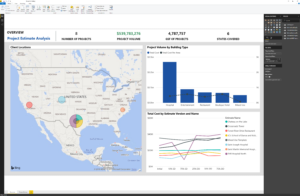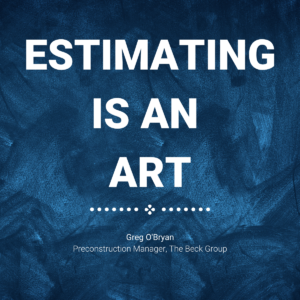What Does DESTINI Estimator Software Do?
What does DESTINI Estimator, our flagship construction estimating software, actually do? What role does it play in preconstruction efforts?
DESTINI Estimator is the best estimating software for preconstruction with built-in takeoff that supports the entire preconstruction data lifecycle, allowing estimators to make the best project decision based on data and deliver consistently accurate estimates to owners.
The below video highlights four key DESTINI Estimator features that our customers love.
- Templates
- Capture, visualize, and leverage data
- Flexibility provided by the option to display multiple views
- Access to all necessary tools (reports, 2D & 3D takeoff, cost history) in one integrated platform
If you are considering upgrading your existing estimating software, you don't want to miss it!
Templates
Estimate templates allow users to take a location and then set data tags—also known as properties—that will then always be associated with that particular type of project. Any time a new project of that type is created, the user will immediately be presented with the template for that project type in an estimate form so that the user can get to work right away. Meanwhile, the properties associated with the project type will continue feeding into the data being created, thus pushing that data in a unified manner into the cost history database and removing the need for manual moving and unification of the data.
Capture, Visualize, and Leverage Data
 Quickly show owners where your numbers come from on visually appealing and easy-to-understand graphs through Power BI.
Quickly show owners where your numbers come from on visually appealing and easy-to-understand graphs through Power BI.One of the most significant challenges for preconstruction teams is capturing and visualizing data in a uniform way so that they can leverage this data across all projects.
Thanks to DESTINI Estimator's powerful integration with Microsoft’s PowerBI software, estimators can create dashboard visualizations of the data they’re generating in their estimates. These dashboards can be quickly broken down even further by using filters that let users see, in real-time, what the estimate will look like if categories like region, material, or square footage are adjusted for.
Flexibility Provided by the Option to Display Multiple Views
 Our clients are in agreement: there is more to estimating than just pure numbers!
Our clients are in agreement: there is more to estimating than just pure numbers!Estimating at its core is largely scientific, in that it’s almost all based on quantitative, not qualitative, work. However, it’s undeniable that there is also an art to good estimating.
Estimators do deal with objective numbers, but the total cost is ultimately just a prediction—after all, that’s why it’s called an estimate! As Chris says: “Do I have the flexibility to tell the story that I want to tell? Am I going to be able to maintain that artistic nature of estimating that ultimately helps me differentiate myself from my competition?”
That flexibility comes in several different forms in DESTINI Estimator. The first is the estimate view, which is powered by what we affectionately call an “Excel emulator.” It’s not Excel—it’s better. Anything that you can do in Excel, you can do in this emulator, and you don’t have to worry about being disconnected from your actual estimate. The genius of this emulator is that it allows customers to quickly put market sector templates together so that if an estimator needs to get a pretty defendable number to an owner in a short turnaround, they can easily do so.
The second is the output or dashboard view. For example, let’s say an owner asks for a custom report. Instead of having to do a ton of manual manipulation, an estimator can just bring those numbers into a dashboard, do some basic linking, and then anything they do within the estimate will automatically update that visual dashboard. So, if you need to introduce a 10% escalation to a 3.6-million-dollar estimate, you can do that, and the dashboard will reflect the change to 3.8 million dollars.
Access to all Necessary Tools in One Integrated Platform
Last but certainly not least, the fourth key feature that DESTINI Estimator offers is access to all your relevant preconstruction tools in one integrated preconstruction software so that you’re no longer having to jump in and out of your estimate to perform takeoffs or access historical data. “The days of having an estimating tool and then a takeoff tool, maybe a 3D takeoff tool, maybe some spreadsheets for conceptual estimating and maybe a separate cost history tool—those things are quickly leaving us,” says Chris.
DESTINI Estimator tackles the issue of separate tools in a couple different ways. The most significant one is the ability to create comparison reports. Comparison reports allow users to do exactly what it says on the tin: compare multiple versions of a project. This feature is critical to maintaining estimate accuracy, because when estimators can compare their current projects to past ones, it’s much easier for them to see if there’s a line item or other scenario they might be overlooking.
DESTINI Estimator also provides users with integrated 2D and 3D takeoff. What this means practically is that instead of having to execute three hundred takeoffs in OST and then manually transfer each one into your estimate, Estimator allows you to execute your takeoff and automatically bring the resulting line items into your estimate without ever having to leave the software. The predicted cost will automatically update so that you can then see countless iterations of drawings.
Ready To See It For Yourself?
We hope that this high-level overview of DESTINI Estimator’s three major features has enlightened you and answered at least some of your burning questions. But if you find that after reading this you still have a lot more questions you’d like answered, schedule a hands-on demo with our team by hitting the button below.

-1.png?width=112&height=112&name=image%20(4)-1.png)















